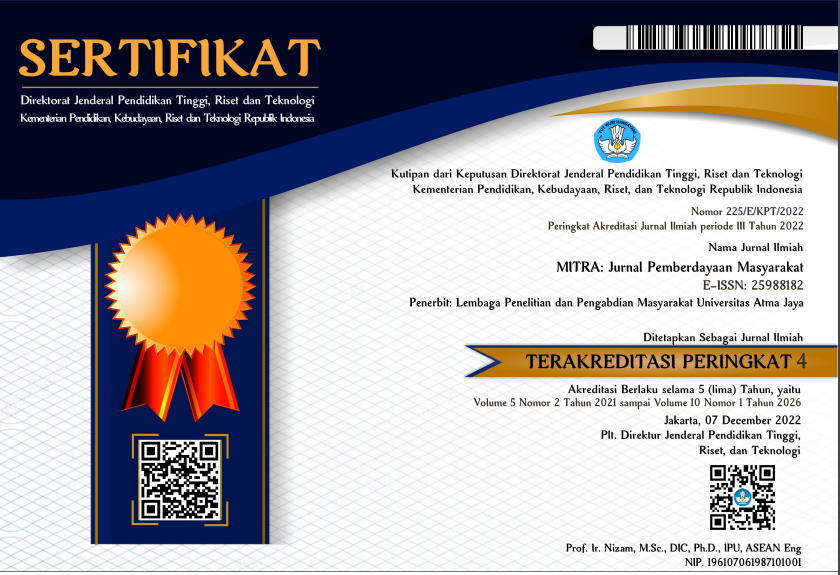The Training of Health Cadre as an Effort to Prevent the Transmission of HIV/AIDS to Pregnant Women
DOI:
https://doi.org/10.25170/mitra.v5i2.2264Kata Kunci:
HIV/AIDS, health cadre, trainingAbstrak
The degree of public health in a country can be reflected in the number of health cases resulting in maternal and infant mortality. The mortality rates can further increase with the cases of HIV transmission from mother to child. Therefore, to mitigate this issue, there should be a program that can provide basic health services. One such program was once conducted in the Center for Public Health through VCT services. However, this program did not manage to lower the case counts as expected. The presence of midwives in the health facilities is observed to be inadequate in attracting pregnant women to undergo ANC services. Furthermore, there are still cases of delay in the pregnant women’s first visit to the health service, rendering it too late to identify pregnant women with HIV. The Mitra Village Development Program (PPDM) in Dolok Hataran Village, Siantar District, Simalungun Regency, was then conducted and enhanced the health cadres’ knowledge about the measures taken to prevent HIV/AIDS transmission from pregnant women to their babies, also able to provide counseling practices. The method of activity is training of 24 health cadres of Batu Anam Health Center, Simalungun Regency, and counseling practices with pregnant women. This activity succeeded in increasing the knowledge of cadres and cadres able to conduct counseling practices.
Referensi
Ningsih, I. K. (2018). Kajian pencegahan penularan HIVdari ibu ke anak pada antenatal care oleh bidan praktik Mandiri di Yogyakarta. Jurnal Administrasi Kesehatan Indonesia, 6(1), 61–67. https://doi.org/10.20473/jaki.v6i1.2018.61-67.
Notoatmodjo, S. (2011). Kesehatan masyarakat, ilmu & seni – Ed Revisi 2011. In Rineka Cipta- Jakarta. Jakarta: Rineka Cipta.
Rosenstock, I. M., Strecher, V. J., & Becker, M. H. (1988). Social learning theory and the health belief model. Health Education Quarterly, 15(2), 175–183. https://doi.org/10.1177/109019818801500203.
Sallis, J. F., Owen, N., & Fisher, E. B. (2008). Ecological models of health behaviour. In:Glanz K, Rimer BK, Viswanath K, eds. Health behaviour and health education:Thoery, research, and practice, 4th edn. In San Francisco, CA: Jossey-Bass. https://doi.org/10.7326/0003-4819-116-4-350_1.
Samaran, E., Shaluhiyah, Z., & Sriatmi, A. (2013). Implementation screening program of the “Prevention of Mother to Child Transmission of HIV” (PMTCT) by Midwives in health center at Sorong West Papua. Jurnal Manajemen Kesehatan Indonesia, 1(3), 206–215. https://doi.org/10.14710/JMKI.1.3.2013.
SDKI, BKKBN, BPS, Kemenkes, & USAID. (2017). Survey demografi dan kesehatan Indonesia 2017. In Survey Demografi dan Kesehatan Indonesia 2017.https://doi.org/10.1111/j.1471-0528.2007.01580.
Simangunsong, D. E., Sianipar, K., & Purba, J. (2020). Preventions of HIV / AIDS Transmission from mother to child in Pematangsiantar City , Indonesia. 12(11), 83–88. https://doi.org/10.5539/gjhs.v12n11p83.
Simangunsong D.E., Sianipar K., P. J. (2020). Perilaku dan persepsi keyakinan ibu hamil terhadap screening HIV di kota pematangsiantar. Jurnal Penelitian Kesehatan" SUARA FORIKES"(Journal of Health Research" Forikes Voice"), 11(2), 202–207. https://doi.org/http://dx.doi.org/10.33846/sf.v11i2.759.
Unduhan
Diterbitkan
Cara Mengutip
Terbitan
Bagian
Lisensi
This license allows reusers to distribute, remix, adapt, and build upon the material in any medium or format for noncommercial purposes only, and only so long as attribution is given to the creator. If you remix, adapt, or build upon the material, you must license the modified material under identical terms.







_.jpeg)




.png)
2.png)
.png)
.png)



